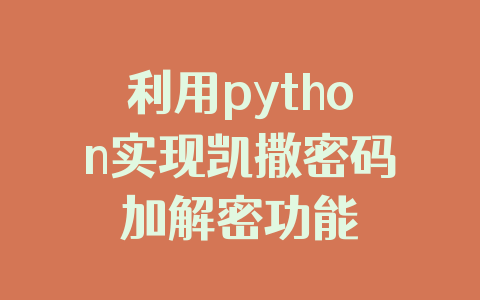本文实例讲述了python实现与redis交互操作。分享给大家供大家参考,具体如下:
相关内容:
- redis模块的使用
- 安装模块
- 导入模块
- 连接方式
- 连接池
- 操作
- 设置值
- 获取值
- 管道
- 事务
- 订阅\\发布
首发时间:2018-03-14 15:02
python可以使用redis模块来跟redis交互
redis模块的使用:
- 安装模块: pip3 install redis
- 导入模块:import redis
- 连接方式:
- 连接池:
- 为了节省资源,减少多次连接损耗,连接池的作用相当于总揽多个客户端与服务端的连接,当新客户端需要连接时,只需要到连接池获取一个连接即可,实际上只是一个连接共享给多个客户端。
import redis pool= redis.ConnectionPool(host=\'localhost\',port=6379,decode_responses=True) r=redis.Redis(connection_pool=pool) r2=redis.Redis(connection_pool=pool) r.set(\'apple\',\'a\') print(r.get(\'apple\')) r2.set(\'banana\',\'b\') print(r.get(\'banana\')) print(r.client_list()) print(r2.client_list())#可以看出两个连接的id是一致的,说明是一个客户端连接
- 为了节省资源,减少多次连接损耗,连接池的作用相当于总揽多个客户端与服务端的连接,当新客户端需要连接时,只需要到连接池获取一个连接即可,实际上只是一个连接共享给多个客户端。
- 操作:
- 值的设置和获取,可以参考redis的命令,redis模块中的对应功能的函数名基本与redis中的一致
- 【注意默认情况下,设置的值或取得的值都为bytes类型,如果想改为str类型,需要在连接时添加上decode_responses=True】
- 设置值:
- redis中set() ==>r.set()
- redis中setnx() ==>r.set()
- redis中setex() ==>r.setex()
- redis中setbit() ==>r.setbit()
- redis中mset() == > r.mset()
- redis中hset() ==>r.hset()
- redis中sadd() == >r.sadd()
- 其他。。。基本redis的命令名与redis模块中的函数名一致
- 获取:
- redis中get() ==》r.get()
- redis中mget() ==》r.mget()
- redis中getset() ==》r.getset()
- redis中getrange() ==》r.getrange()
- 其他。。。基本redis的命令名与redis模块中的函数名一致
如果想要了解更多redis命令,可以参考我的另外一篇博文:
一文学redis操作(记录向)<点击即可跳转>
import redis r=redis.Redis(host=\'localhost\',port=6379,decode_responses=True) # r=redis.StrictRedis(host=\'localhost\',port=6379) r.set(\'key\',\'value\') value=r.get(\'key\') # print(type(value)) print(value) r.hset(\'info\',\'name\',\'lilei\') r.hset(\'info\',\'age\',\'18\') print(r.hgetall(\'info\')) r.sadd(\'course\',\'math\',\'english\',\'chinese\') print(r.smembers(\'course\'))
管道:
一般情况下,执行一条命令后必须等待结果才能输入下一次命令,管道用于在一次请求中执行多个命令。
- 参数介绍:
- transaction:指示是否所有的命令应该以原子方式执行。
import redis,time r=redis.Redis(host=\"localhost\",port=6379,decode_responses=True) pipe=r.pipeline(transaction=True) pipe.set(\'p1\',\'v2\') pipe.set(\'p2\',\'v3\') pipe.set(\'p3\',\'v4\') time.sleep(5) pipe.execute()
事务:
python中可以使用管道来代替事务:
- 补充:监视watch:pipe.watch()
import redis,time import redis.exceptions r=redis.Redis(host=\'localhost\',port=6379,decode_responses=True) pipe=r.pipeline() print(r.get(\'a\')) try: # pipe.watch(\'a\') pipe.multi() pipe.set(\'here\', \'there\') pipe.set(\'here1\', \'there1\') pipe.set(\'here2\', \'there2\') time.sleep(5) pipe.execute() except redis.exceptions.WatchError as e: print(\"Error\")
订阅\\发布:
- 发布方:
import redis
r=redis.Redis(host=\"localhost\",port=6379,decode_responses=True)
#发布使用publish(self, channel, message):Publish ``message`` on ``channel``.
Flag=True
while Flag:
msg=input(\"主播请讲话>>:\")
if len(msg)==0:
continue
elif msg==\'quit\':
break
else:
r.publish(\'cctv0\',msg)
import redis r=redis.Redis(host=\"localhost\",port=6379,decode_responses=True) #发布使用publish(self, channel, message):Publish ``message`` on ``channel``. Flag=True chan=r.pubsub()#返回一个发布/订阅对象 msg_reciver=chan.subscribe(\'cctv0\')#订阅 msg=chan.parse_response()#第一次会返回订阅确认信息 print(msg) print(\"订阅成功,开始接收------\") while Flag: msg=chan.parse_response()#接收消息 print(\">>:\",msg[2])#此处的信息格式[\'消息类型\', \'频道\', \'消息\'],所以使用[2]来获取
更多关于Python相关内容感兴趣的读者可查看本站专题:《Python常见数据库操作技巧汇总》、《Python编码操作技巧总结》、《Python数据结构与算法教程》、《Python Socket编程技巧总结》、《Python函数使用技巧总结》、《Python字符串操作技巧汇总》、《Python入门与进阶经典教程》及《Python文件与目录操作技巧汇总》
希望本文所述对大家Python程序设计有所帮助。













